CONCRETO PRODUZIDO COM AGREGADO GRAÚDO LATERÍTICO EM SANTARÉM, PARÁ
DOI:
https://doi.org/10.5216/reec.v16i1.61937Resumo
RESUMO: Avaliou-se a substituição da brita basáltica existente no concreto por material alternativo em abundância no município de Santarém-PA: a laterita. Foi avaliado o desempenho do concreto incorporado com agregado laterítico in natura em substituição parcial ao agregado graúdo de brita basáltica nos teores de 20% e 50%. Realizou-se a caracterização dos agregados graúdo e miúdo. De acordo com o método da ABCP, determinou-se o traço de referência em massa 1:1,71:3,03:0,53; confeccionou-se corpos-de-prova cilíndricos 10x20 cm utilizando 3 traços diferentes, de modo a substituir a brita basáltica pelo agregado laterítico, em 20% e 50%. Para cada traço foram quantificados a sua consistência, por meio do ensaio de abatimento do tronco de cone, resistência à compressão axial, resistência à tração por compressão diametral e módulo de elasticidade aos 28 dias. A substituição do agregado convencional de brita basáltica por agregado laterítico em seu estado natural promoveu diminuição da resistência a compressão simples, da resistência à tração por compressão diametral e do módulo de elasticidade com a inclusão do agregado laterítico na mistura. Destaca-se que acima de determinado teor de substituição o concreto torna-se inviável devido a necessidade de adicionar aditivo plastificante para manter a consistência desejada e que as duas misturas incorporadas com agregado laterítico se mostraram muito semelhantes após os 28 dias, no que tange a ganhos de resistência a compressão.
ABSTRACT: This study is about the replacement of basaltic origin crushed stone by alternative material present in the municipality of Santarém, Pará State: the laterite. The aim were to evaluate the performance of concrete incorporated with natural lateritic aggregate, replacing the of crushed stone in 20% and 50%. The first stage was characterizing the coarse and fine aggregates that made up the studied concrete. According to ABCP dosing method it was determined the mass reference trait 1: 1.71: 3.03: 0.53; bodies of 10x20 cm were made for cylindrical test, using three different strokes so that the basaltic crushed stone gradually replaced by the lateritic aggregate in proportions of 20% and 50%. For each trait its consistency was quantified by means of the tapering test, axial compression strength, diametric compression tensile strength and the modulus of elasticity at 28 days. Was observed that the replacement of the conventional aggregate basalt crushed stone for aggregate of laterite in natural state promoted a decrease in the value of simple compressive strength, diametric tensile strength and modulus of elasticity with inclusion of a larger amount of lateritic aggregate in the mixture. It is noteworthy that above a certain substitution content, the concrete becomes not feasible due to the need for a large increase in the amount of plasticizer additive to the desired consistency is maintained and the two blends incorporated with lateritic showed very similar after 28 days in terms of gains in compressive strength.
Downloads
Downloads
Publicado
Como Citar
Edição
Seção
Licença
Autores que publicam nesta revista concordam com os seguintes termos: Autores mantém os direitos autorais e concedem à revista o direito de primeira publicação, com o trabalho simultaneamente licenciado sob a Licença Creative Commons Attribution que permite o compartilhamento do trabalho com reconhecimento da autoria e publicação inicial nesta revista.
![[REEC] Revista Eletrônica de Engenharia Civil](https://revistas.ufg.br/public/journals/30/pageHeaderLogoImage_pt_BR.png)



